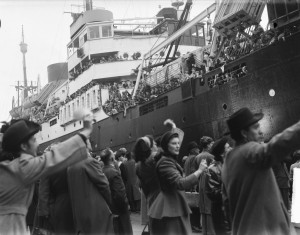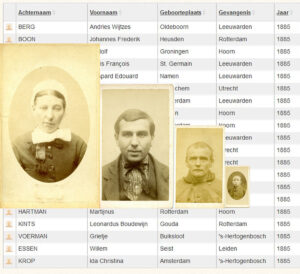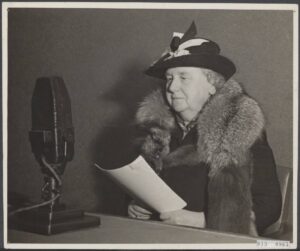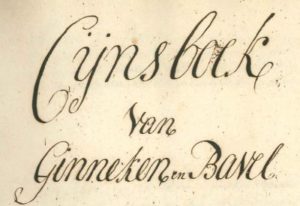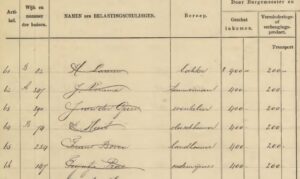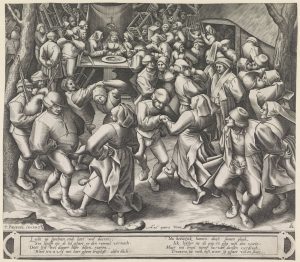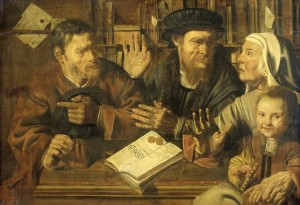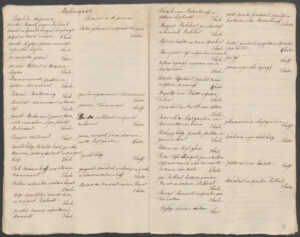In the 1840s, when religious tensions were high and crops were failing, many people left the Netherlands to start a new life in America. The national government wanted to know what was going on. Since 1848, they required each province to keep lists of emigrants, the "Staten van Landverhuizers" [tables of emigrants]. Between 1831 and 1847, only numbers were recorded, but since 1848 the heads of households were listed. Contents of the Staten van Landverhuizers The provincial lists were compiled … [Read more...]
Source – Staatscourant [National Gazette]
The Staatscourant [National Gazette] is the official newspaper of the Dutch government. Established in 1814, the gazette publishes all laws, regulations, and other official announcements of the Netherlands. Genealogical information in the Staatscourant Some announcements deal with individuals. A few examples of genealogical information you can find in the gazette: Appointments, transfers, promotions, or pensions of civil servants, including public school teachers, police officers, etc. … [Read more...]
Source – Secret Register of Released Prisoners
A source with an intriguing name is the "Geheim Register van Ontslagen Gevangen" or the Secret Register of Released Prisoners. This register was kept from 1882 to 1896 and included the photos, personal details, and overview of crimes of the prisoners who would be released in the upcoming month even though they were still considered dangerous. This included people who served multiple sentences, or who served a long sentence for a serious crime. … [Read more...]
Source – Royal Decree
A Royal Decree (Koninklijk Besluit) is a formal decision by the King or Queen. In the Netherlands, royal decrees started in 1813. Contents Royal decrees covered a range of topics. Some were of (inter)national importance, such as treaties, laws, and abdications. But many dealt with individual citizens, employees, or service personnel. These can be a great source for information about your ancestors. Examples of information about your ancestors you may find in royal decrees: Marriage … [Read more...]
Source – Resolutions of the States-General
The States-General was the governing body of the Dutch Republic between 1576 and 1796. The body was composed of representatives of the seven participating provinces. The States-General formed both the legislative and executive branch of the government. Their political decisions are called resolutions. The resolutions of the States-General dealt with a range of issues: from international treaties to individual appointments. Digitization and Transcription Between 2019 and 2024, the resolutions … [Read more...]
Source – Rent Registers
"Cijnzen" or rents are rights to annual proceeds. The rights could be attached to land or property, certain official functions, or rights in common grounds. In the Middle Ages up until say the 1700s, rents were often paid in kind, for example in grain. Dominion rents Rents could be attached to a domain, the area belonging to an overlord. For example, the overlord could give land to a family in exchange for an annual payment. These rents were perpetual. Rents could also be required to pay in … [Read more...]
Source – Records of the municipality
In 1812, the Netherlands had more than 1,100 different municipalities. Since then, many have merged so we have about 350 left. See the Gemeentegeschiedenis website for an overview of all the municipalities that ever existed. Each of these municipalities created a wide range of records. Typical categories include: Records created by mayors, aldermen, municipal council, such as minutes of meetings, correspondence, municipal reports Various departments within the municipality … [Read more...]
Source – Publication of the banns
In the Netherlands, you have to go in "ondertrouw" before you get married. This means that the banns are read, giving everyone in the community a chance to object to the marriage. In the period before the introduction of the civil registration, church records are the most important source of vital information. Many churches recorded the banns rather than the marriage. They recorded when the couple registered the banns, and sometimes noted the marriage announcements on three different times, … [Read more...]
Source – Notarial records
Notarial records are created by a public notary and serve as legal proof of the information contained in the record. Information in notarial records Examples of the types of records you can find in notarial archives are: Real estate transactions (sales, conveyance) Debts Obligations Auctions Prenuptial agreements Last wills Estate divisions Work contracts Replacement contracts for enlisted men Powers of attorney A notary created copies of most of the records … [Read more...]
Source – Mill tax records
Before say 1800, taxes varied widely depending on the location. Several provinces instituted a mill tax; a tax on grinding grain. The tax could be levied in different ways. Often, a fixed sum was charged per head, with a reduced rate for children under 16. In some jurisdictions, the tax collector collected the taxes and recorded who paid what. In other jurisdictions, the tax was leased to the highest bidder, who would then collect the taxes and got to keep any profits above the paid sum. In … [Read more...]
